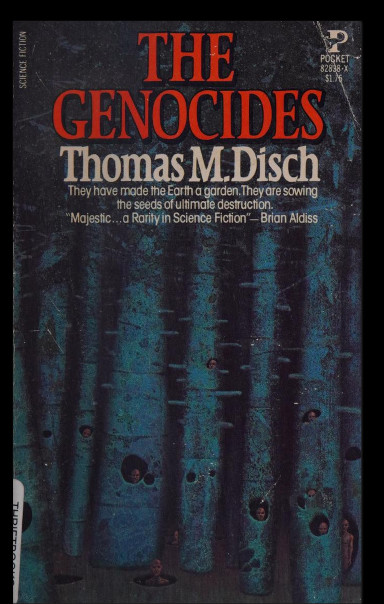
The novel “The Genocides” by Thomas M. Disch was published for the first time in 1965.
A few years after the appearance of the Plants, the Tassel community on the shores of Lake Superior struggles to survive. Anderson is formally the village’s mayor, but he’s actually a sort of absolute king, ruling the small group of survivors with an iron fist, using a gun as a symbol of his power.
When another group of survivors, traveling in search of stability, approaches the village, its members are mercilessly killed. Only Jeremiah Orville, a mining engineer, and nurse Alice Nemerov, considered useful to the community, are spared. The Plants are making it increasingly difficult to grow crops and raise animals, and the arrival of spheres that set buildings ablaze triggers an even deeper crisis, especially as Anderson grows weaker.
“The Genocides” is Thomas M. Disch’s debut novel after publishing short fiction in previous years. The author stated that he was reading “Anna Karenina” while writing the first draft of his novel and was influenced by Leo Tolstoy’s prose.
This novel begins a few years after an unusual invasion, as it appeared in the form of unknown plants. Humanity doesn’t even have time to study them, and they’re known only as the Plants. They grow everywhere and very quickly, causing an ecological catastrophe by replacing all other forms of vegetation. No one knows their origin, and human civilization collapses along with the ecosystems before any answers can be found.
The small community of survivors at the center of the novel shows how humanity has quickly regressed in every way. The loss of modern technology forces the community to struggle every day to fight the advance of the Plants. Socially, too, there’s a regression, with Anderson effectively becoming a sort of absolute ruler who decides who lives and who dies.
From the beginning, we see how Anderson has also become a sort of community priest, a role he assumed after the death of its real priest. His actions are steeped in Christianity, but he has two children of very similar ages, fathered by two different women, as his wife and his mistress became pregnant near the same time.
Thomas M. Disch gradually reveals the strengths, and especially the weaknesses, of Anderson and the other protagonists. Even within his own family, disagreements are prevalent and deepen as time passes. Divisions are also deep within the rest of the community, with people such as Jeremiah Orville, who seeks revenge for the murder of his wife.
In this mix of assorted pettiness and personal grudges, all peppered with religion, no one can find countermeasures to the Plants’ advance. There are some attempts to adapt to their presence, such as using their sap to fuel crops, but the resulting balance is precarious.
The appearance of spherical machines that come to destroy the little that remains of human civilization seems to confirm that the Plants were brought by an external force. Their attack brings the survivors’ regression to an even lower level, as they’re forced to take refuge in a cave.
Humans become increasingly irrelevant, which further stresses the pettiness of many of their actions. At the start, Tassel’s population is 247, but every danger, natural or otherwise, results in someone’s death. Even with their survival hanging by a thread, within an ever-shrinking group, divisions that sometimes erupt into conflict seem to remain the priority.
“The Genocides” can be disturbing due to its brutal descriptions of the remnants of humanity descending into an ever-deeper abyss, in every sense of the word. Thomas M. Disch uses no subtlety in describing the survivors reduced to parasites, and it’s precisely for these characteristics that this apocalyptic story has become a classic worth reading decades later. It’s available on Amazon USA, UK, and Canada.

